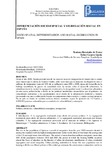Mostrar el registro sencillo del ítem
Diferenciación socio-espacial y segregación racial en España
| dc.creator | Hernández de Frutos, Teodoro | es_ES |
| dc.creator | Casares García, María Esther | es_ES |
| dc.date.accessioned | 2018-08-31T08:07:56Z | |
| dc.date.available | 2018-08-31T08:07:56Z | |
| dc.date.issued | 2016 | |
| dc.identifier.issn | 1575-0825 (Print) | |
| dc.identifier.issn | 2172-3184 (Electronic) | |
| dc.identifier.uri | https://hdl.handle.net/2454/30344 | |
| dc.description.abstract | Desde el año 2000, España presentó una de las mayores tasas de inmigración del mundo (tres a cuatro veces mayor que la media de Estados Unidos, ocho veces más que la francesa). La llegada de unos 4 millones de inmigrantes (más del 10% de su población) entre 2001 y 2005, época del desarrollo de la burbuja inmobiliaria ha puesto de actualidad todas las teorías sobre el desarrollo urbanístico, la estratificación de la ciudad, la segregación residencial y la desigualdad racial. La absorción urbanística de esta nueva población fue a través de las políticas neoliberales desarrolladas por el gobierno, las comunidades autónomas y los ayuntamientos en el diseño de la urbanización territorial y humana provocando una nueva polarización basada en componentes étnico-raciales y estatus socioeconómicos. En un país en donde no existían enclaves étnicos asentados supuso la aparición de 112 barrios y 1.029.699 personas vulnerables por su condición de vulnerabilidad y extranjería. | es_ES |
| dc.description.abstract | The rise in the population of Spain as a result of emigration from the year 2000 onwards situated it among the countries with the highest immigration rates in the world: three or four times the average rate of the US and eight times that of France. The arrival of more than four million immigrants (more than 10% of the population) between 2001 and 2005, the period in which the housing bubble occurred, placed the focus of attention on the theories of urban development, stratification of cities, residential segregation and racial inequality. Urban planning undertaken to house this new population was in keeping with the neo-liberal policies of the central government, the autonomous communities and town councils. This brought about situations of inequality, a polarization of society and did not solve the problem of meeting the demand for housing for the immigrant population. In a country where ethnic ghettoes had never existed, 112 of such areas were created and 1.029.699 people found themselves in a vulnerable situation. | en |
| dc.format.extent | 19 p. | |
| dc.format.mimetype | application/pdf | en |
| dc.language.iso | spa | en |
| dc.publisher | Asociacion Castellano-Manchega de Sociologia (ACMS) | es_ES |
| dc.relation.ispartof | Barataria. Revista Castellano-Manchega de Ciencias Sociales, (21) 91-109 | es_ES |
| dc.rights | Creative Commons Attribution-NonCommercial-ShareAlike 4.0 International (CC BY-NC-SA 4.0) | en |
| dc.rights.uri | https://creativecommons.org/licenses/by-nc-sa/4.0/ | |
| dc.subject | Política | es_ES |
| dc.subject | Urbanismo | es_ES |
| dc.subject | Vulnerabilidad | es_ES |
| dc.subject | Extranjería | es_ES |
| dc.subject | Inmigración | es_ES |
| dc.subject | Policy | en |
| dc.subject | Urban development | en |
| dc.subject | Vulnerability | en |
| dc.subject | Foreigners | en |
| dc.subject | Immigration | en |
| dc.title | Diferenciación socio-espacial y segregación racial en España | es_ES |
| dc.title.alternative | Socio-spatial differentiation and racial segregation in Spain | en |
| dc.type | info:eu-repo/semantics/article | en |
| dc.type | Artículo / Artikulua | es |
| dc.contributor.department | Sociología | es_ES |
| dc.contributor.department | Soziologia | eu |
| dc.rights.accessRights | info:eu-repo/semantics/openAccess | en |
| dc.rights.accessRights | Acceso abierto / Sarbide irekia | es |
| dc.identifier.doi | 10.20932/barataria.v0i21.298 | |
| dc.relation.publisherversion | https://doi.org/10.20932/barataria.v0i21.298 | |
| dc.type.version | info:eu-repo/semantics/publishedVersion | en |
| dc.type.version | Versión publicada / Argitaratu den bertsioa | es |



